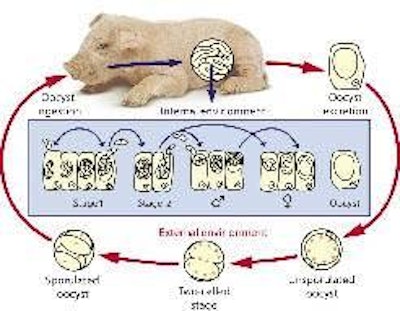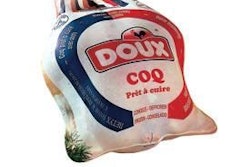
Piglets from birth onwards are at risk of picking up a coccidial infection that develops into diarrhoea. The most recent information about coccidiosis also tells us that this economically important disease of young pigs is insidious. Coccidiosis is not only a reason for piglets to scour — it may be present as well at a subclinical level, resulting in poorer development and reduced weight gain. One indicator that the infection is affecting pigs subclinically can be that the litter shows uneven growth.
We are talking here about infection with Isosopra suis, an intracellular protozoan parasite which infects the gut's mucosa cells. Piglets are often infected with these coccidia shortly after birth, in herds where the incidence is quite high. Also clear to investigators is that it takes only a very few oocysts of I. suis for the baby pig to become infected. As few as 100 sporulated oocysts have produced severe disease under experimental conditions of infection.
Equally, it can now be said that the most important factor determining the outcome of the infection is the age of the piglet. The younger the animals, the more susceptible they will be. When we compare it with the situation in early life, a coccidial infection in older pigs after weaning is seen to be less pathogenic and therefore less relevant in economic terms.
Clinical signs in the form of diarrhoea develop quickly after the baby pig picks up sporulated oocysts. The so-called prepatent period of I. suis is only about 4-6 days. In most cases the diarrhoea occurs between 8 and 15 days of age, which is why this infection is often named in the literature as ‘10-day scour'.
Coccidia rarely work alone. A secondary bacterial complication is also to be expected. This makes the control of isosporosis (coccidiosis due to Isospora suis) in piglets much more important, because of the increase in severity of the overall effects.
Successful programmes to control coccidiosis combine good management, hygiene and chemotherapy. Complete eradication of Isospora suis is impossible, but infection pressure and spread of disease can be limited in a clean and dry environment. We recommend actions that help to minimise a build-up of infectious oocysts, which should include limiting the number of potential vectors (insects or rodents) and a regular removal of faeces. In a clean-up of pens the recommended practice is to apply high-pressure cleaning with hot water (>70°C) followed by disinfection with a product containing cresolic acid, chlorine or ammonia in a 50% solution.
In addition to improved hygiene with regular disinfection, further assistance in the control of coccidiosis can come from reducing the stocking density of pens, changing to a better litter quality and improving the ventilation. These then support the use of chemotherapy through applying anticoccidials that act systemically, quickly and intracellularly.
An experimental study reported in 2007 has demonstrated the protection of piglets available from dosing them orally with the anticoccidial drug toltrazuril. Marketed as Baycox, a 5% oral suspension formulation of toltrazuril is developed for administering to piglets during the first 5 days of life. The administration gives a dosage of 20mg toltrazuril per kilogram bodyweight to control the coccidiosis before the infection causes damage in the gut.
Toltrazuril affects the asexual and sexual reproduction stages of the coccidial parasite and therefore achieves a breakdown in its life-cycle. The study gave the recommended dosage of the drug, 2 days after experimental infection with I. suis, and compared the results with those from applying diclazuril (2 mg/kg bodyweight) on 2 occasions or sulphadimidine (200 mg/kg) on 3 occasions to other infected pigs. Changes in the intestine, weight gain, shedding of oocysts and faecal score were compared between groups.
Diarrhoea was seen as semi-liquid and liquid faeces from 5 days post-infection in all groups except the one treated with Baycox. The difference was significant. Oocyst excretion was markedly and significantly controlled by Baycox treatment compared to other groups. Also, piglets in this group gained significantly more weight in 4 weeks.
Histo-pathology showed necrosis and atrophy of villi in the small intestines except the duodenum, with a peak at 7 days after infection, in all groups except the one on Baycox. Between 5 and 11 days post-infection, this toltrazuril group had significantly longer villi than the others. PIGI

















